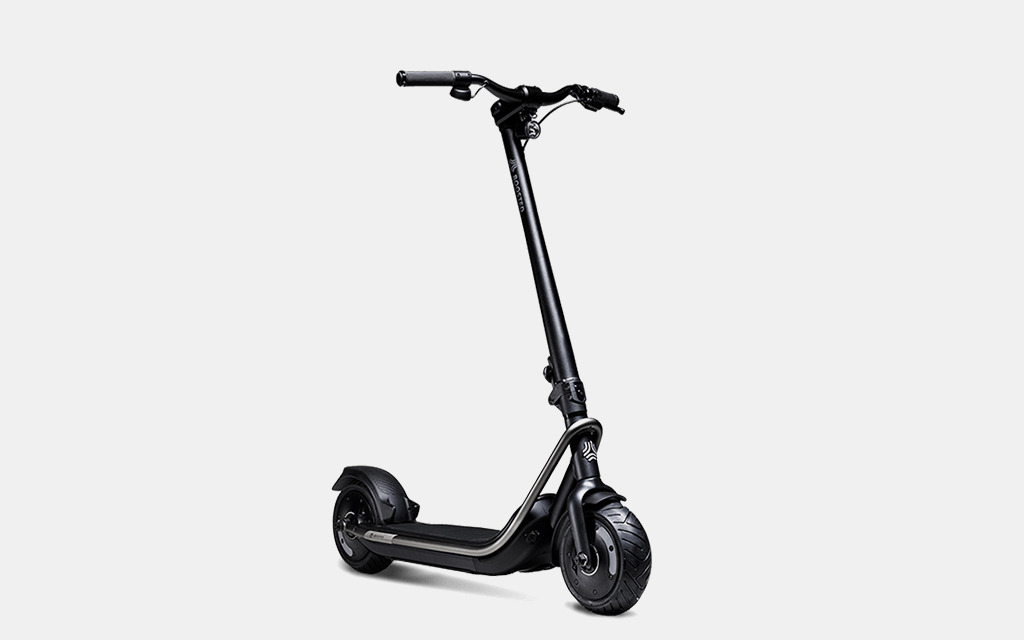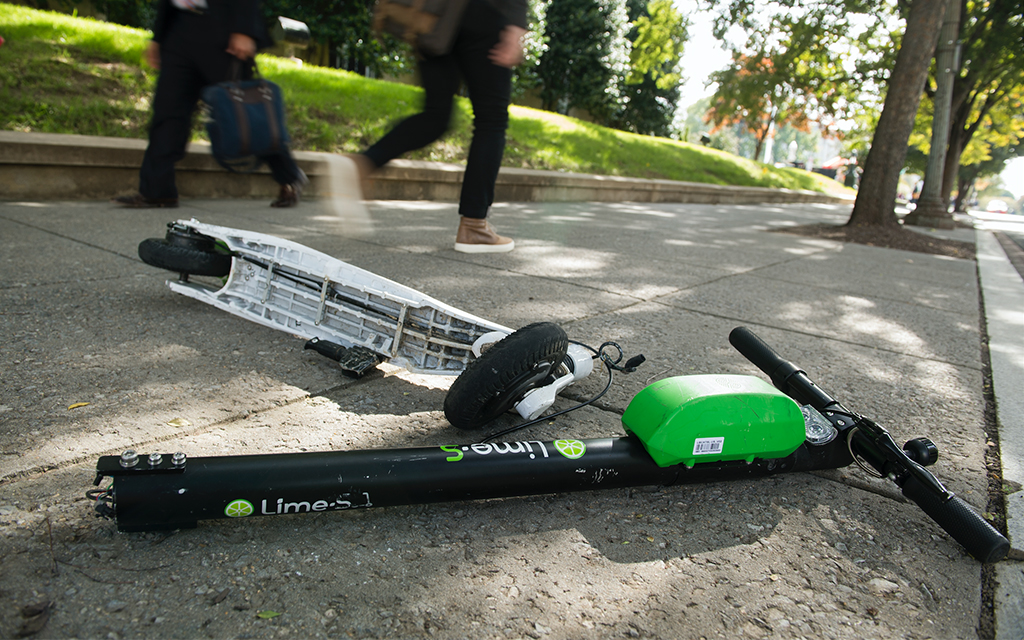
“We’re not going to release something if we don’t think it’s sexy,” Bobby Dunn said as we rode past the Staten Island Ferry Station. As if to illustrate his point, he swerved his electric skateboard, an onyx-coated Boosted Stealth, and effortlessly avoided a family of tourists who’d bumbled into the opposing bike lane.
The sky had been a steamship gray all morning, and it finally burst just two minutes into our ride, releasing an early-December, Old-Testament downpour over the jigsaw of park, cobblestone and promenade that make up Manhattan’s southernmost reaches. I’d met with Dunn — a marketing executive at Boosted who joined the company in 2014 — to take a test run on Boosted’s latest product, the Boosted Rev, an e-scooter which dropped in May of this year. I was familiar enough with the SF-based brand, having previously tested the Plus (a standard, full-size e-board) and knew that Boosted prides itself on riders enjoying a smooth trip and doing so with very little learning curve — no scabbed knees necessary.
As we made our way from Battery Park toward the South Street Seaport, Dunn filled me in on how to work the Rev. The machine has three breaks: one on the mountain bike-inspired handlebars, another on the rear fender, and the third via the “joystick,” a grip-stubbled speed controller below the right handlebar, which employs the same technology found in Boosted’s unique e-board remotes. Flicking the dial to the left makes the scooter move forward (to its top speed of 24 mph), flicking it to the right makes it slow down. The brakes are electric, so the scooter interprets commands almost instantaneously (though without chucking you over the top like a mechanical bull). Even while navigating the unholy mess of infrastructure that is downtown New York City, among power lunchers, Citi bikers, lost families and smoking construction workers, I found my groove. I revved the Rev up to 18.
“It’s intuitive!” I shouted appreciatively to Dunn.
Then it started to pour. I dialed the Rev back to a crawl.
“Uh. Are we good?”
“Yeah!” Dunn replied, unfazed. “We’ve ridden these things through everything. And we beat the crap out of them in testing.”
Indeed, the Rev didn’t seem to mind a little rain. Or a lot of rain. The tires, which contain an electric motor and weigh eight pounds apiece, blasted through puddles and off curbs with the confidence of a backcountry ATV. It occurred to me, despite my chattering teeth and “What decisions did I make in my life again to get here on a Tuesday morning?” face, that to ogling passersby, I looked like I knew what I was doing.
Of course, they weren’t ogling me, but my steed. The Boosted Rev’s powder-coated aluminum frame wouldn’t look out of place in Lucius Fox’s laboratory, and it weaves on the roads like a speeder bike from Return of the Jedi. Hours later, after I’d said my goodbyes and cranked the thing all the way up the Hudson River Greenway to InsideHook’s office in Midtown, I wasn’t surprised to read that it had made Time’s 100 Best Inventions of 2019.

That honor, on paper, is thanks to a rare combination of high-performance specs and curb appeal. The Boosted Rev checks boxes galore; it can travel 22 miles off a single charge, dunks on hills up to a 25% grade, features three different ride modes for various levels of experience (Dunn had put me on Level 3 at the outset, which hits the full 24 mph) has a waterproof drivetrain, folds down easy (even for me, and I can’t close an umbrella) and allows for a more natural riding stance — with a tilted frame and wide-base platform, you can stand like a surfer or batter, instead of a nervous newlywed at the altar.
It’s all very impressive. But it’s hard not to feel like the inclination towards praise for the Boosted Rev (from me, from Time Inc.) also stems from a place of exhausted, easily impressed relief. In other words, the Rev is as desirable for what it is, as what it isn’t: one of those beleaguered ride-share scooter from four-lettered startups (Bird, Lime, Jump, Skip, Spin) that are currently terrorizing pedestrians all over the country.
If you’ve been to an American city in the last 18th months, you have almost certainly seen these dockless machines scattered around the city; they’re propped against mailboxes, left in parking spaces like grocery carts, and sometimes just strewn across the ground. When low on battery (which is often), they’re collected at a strange hours of the night, thrown in the back of a car and brought home to the living room of a commissioned “juicer,” who’s beaten out other charging contractors for the prize. Cries of hoarding and territorial practices among juicers even led to Lime rolling out a “reserve” feature in cities from Oakland, California, to Auckland, New Zealand, earlier this year.
Related
Can High-Speed Trains Solve America’s Transit Crisis?
What Are Carbon Offsets, and Should You Buy Them When You Fly?
They seemed to arrive without warning. Earlier this year, I wrote that “the phenomenon feels like the idea of a fourth-grader made mayor for the day.” Because however noble the intentions were when these scooters made landfall — life-hack last-mile commuting; provide an energy-efficient transit alternative the public will actually get behind (Americans seem less excited about bicycles than Scandinavians) — they came without rules, without infrastructure and without precedent. Unlocking a scooter follows a similar routine: A) find one, B) open your corresponding app and scan the QR code, C) ride where you need to go, and D) lock it by taking a picture of the QR code. You’re charged a set $1 fee for renting the scooter, plus a per-minute rate.
According to the fine print, you must be 18 or older, you must wear a helmet, you must ride alone and you must have a driver’s license. Of course, these rules are rarely followed and rarely enforced. There have been eight deaths since the end of 2017, and more than 1,500 reports of injuries, which have overwhelmed head-trauma units in hospitals across the country. Cities like Atlanta, Nashville, Portland and San Antonio, sick of inexperienced riders or drunken students hopping on the machines and terrorizing sidewalks, have made it abundantly clear that the scooters aren’t welcome by passing nighttime or outright bans. San Francisco even ousted all the brands for a year — which was pretty significant, considering they’re all headquartered within an hour of the city — before allowing just two brands, Skip and Scoot, to remain.
I’ve ridden a ride-share scooter before. I hawked around Indianapolis on one in July, and in my eyes, at the time, it was an unmatched way to experience the city’s canals and downtown. How fast was it? It maxed at about 15 mph. Did my battery die? Yeah, after about 30 minutes. Was it a sturdy, stable ride? Um, sort of. I didn’t register or care much about the specs. The sheer novelty of the experience was enough, as it is for most first-timers. But the “play” portion of ride-share scooters’ destiny is where most of the trouble has come from. When the scooter (which is flimsy to begin with) becomes more of a vacation gag than a reliable morning commuter, it’s robbed of respect, and eventually of any expectation. It’s no wonder that until recent overhauls (for example, Lime dropped the more robust “Gen 3” last year) most scooters had a street-life expectancy of just six months.

The mayhem of the last year has taken a toll on the economics of scooter-sharing. The Washington Post recently talked with commuters in the nation’s capital who relied on scooters for the final stretch home after getting off the Metro. One man explained that he can’t justify the cost anymore; what was once a $2.80 trip is now $7, about the same as hailing an Uber. That’s because the old rate, which was $1 flat plus 15-cents-per-minute, has now gone up to $1 flat plus 39-cents-per-minute for certain companies. The price has been inflated because scooter-sharing has thus far subsisted on a completely unsustainable business model: the scooters can’t cover their own costs, and more importantly, cities are now charging the brands exorbitant fees and requiring special permits due to all the bad press. A 10-minute ride on a Lime scooter, for instance, now hovers around $3.40. If someone makes that ride twice a day, for five days a week, over the course of a year, they’re looking at more than $1,600 in ride-share fees, on top of whatever they pay for their primary method of transit (subway, bus, ferry, etc.).
But while specific electric-scooter companies may not be sustainable, the concept certainly is. Hoboken, New Jersey, a bricky, leafy college-and-condos town directly across the Hudson from New York City, has recently been experimenting with electric scooters (Lime and Ojo, specifically) and the residents are impressed, which isn’t easy to do — these are New Jerseyans who work in New York, after all. Of those who’ve participated, 64% said e-scooters make it easier to get around, and 74% say they use them to connect with public transportation. Which is … the whole point! They aren’t driving to the Hoboken Train Station and leaving a car parked in the sun all day. They aren’t hailing Ubers. They’re getting to work a little easier, on an electric vehicle. But then, on the weekends, all hell breaks loose. Let’s just say Hoboken has its own SantaCon for a reason.
Whether ride-sharing services remain in Hoboken long-term isn’t really the point. The city’s residents have had a taste of an invention that improves their lives, and that matters. New York is certainly listening. Ride-sharing services will arrive in four boroughs (all but Manhattan) once Governor Cuomo signs a bill to legalize electric-scooters in the state. And unsurprisingly, the infrastructure won’t really be there to support them. Of NYC’s 1,260 miles of bike lanes, only 126 are currently protected (meaning there’s a physical barrier between the road and cyclists). Because of the system’s shortcomings (and increasingly congested roads) due to the influx of ride-share drivers, a tragic 25 cyclists died this year. That’s the highest total in two decades.
It’s why Mayor Bill de Blasio and the City Council agreed on legislation to connect the city’s non-motor vehicle lanes with 250 more miles of lanes. It will take years for the project to come to fruition, but when it’s completed, riding through New York will be less “choose your own adventure” (seriously, if you’re not riding through a quiet stretch of Brooklyn, along the Hudson River Greenway or in Central Park, you’re just making it up as you go along) and actually represent a cohesive network of lanes for cyclists, skaters, and yes, those on electric scooters. Until then (especially assuming the scooters arrive in New York, as scheduled in 2020), it’s going to be a free-for-all.
The singular solution to these issues, from the poor quality (and treatment) of dockless scooters to their rising rates to the obscene legislative and financial uncertainty in the space, occurs at the personal level. We know that electric scooters are a smart environmental solution for urban living. When used correctly, along reliable routes, they make for a worthy solution to the last-mile commute. The issues really come down to ride-sharing. Why share at all?
It all brings us back to the Boosted Rev. At $1,600, the Rev is not exactly something you impulse purchase. You should absolutely do your research, and figure out how if it makes sense with your commuting strategy. But if you can swing it, logistically and financially, it’s worth the plunge.
For years, Boosted only made electric skateboards; Dunn admitted to me that he still prefers riding the board to the scooter. He and the rest of the lifetime-boarder higher-ups at Boosted originally got in this game because “they thought it would be fun.” The scooter is largely about letting everyone else in on that fun. Anyone can ride it, in 10 minutes or less. It won’t die by next July 4th, it won’t need to make midnight trips to living rooms around the city, it can take a beating and over the course of a year, it costs roughly the same as the ride-share grind, which currently checks in at $1,500 and will inevitably keep climbing. If there’s a single concern, it’s probably the weight: at 45 pounds, it’s tough to lug around when folded. But the bottom frame is compatible with a U-lock, so you don’t actually have to lug it up to the office. If the weight proves too much, you can always consider other models on the market. Unagi has gotten a ton of buzz, and deservedly so, for a more lightweight design. You’re sacrificing some beef, though. It’s the beach cruiser to the Rev’s mountain bike.
We’re riding with (and on) Boosted for now, but in the eyes of the consumer and commuter, any competition in the next decade is good. Urbanites should have 10 outstanding personal e-scooters to choose from, not 500 different car makes. It’s time to stop dreaming of flying cars and Rolls Royce drone taxis and whatever other nonsense is caroling throughout the wacky, wayward neighborhood of the internet these days. We’ve already got something to chew on, people. It’s a personal vehicle that doesn’t burn fuel. That can be carried off and on the subway and easily stored in your mudroom. That delivers like a mailman, come rain, sleet or now. The future is already here, people. And it’s very sexy.
This article was featured in the InsideHook newsletter. Sign up now.
























